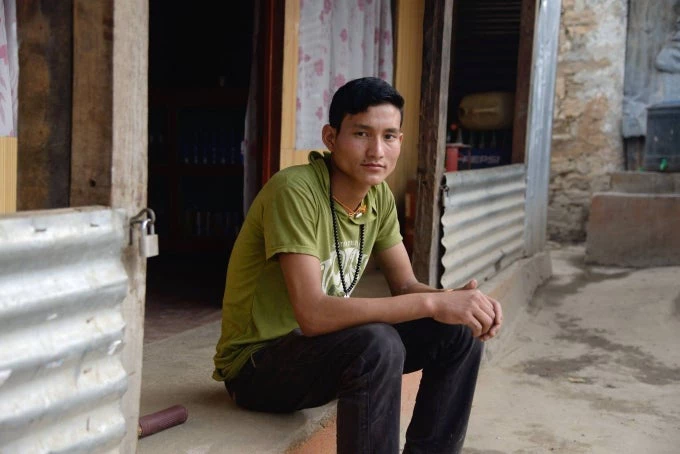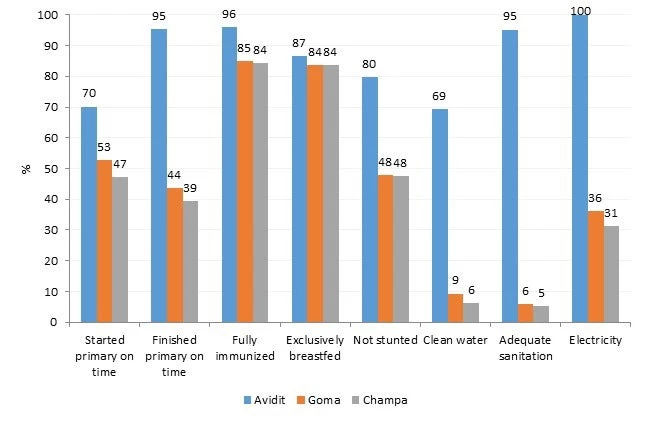

Goma is a girl, born in rural Kalikot. Her parents are illiterate, belong to the Dalit community and are in the bottom 20 percent of Nepal’s wealth distribution. Champa is also a girl born to a household very similar to Goma’s, but her parents are from a village in Siraha. Avidit is a boy born to an upper caste household in urban Kathmandu. Both his parents have a university education and come from affluent backgrounds.
In a society where opportunities are equally available for children of all socio-economic backgrounds, Goma, Avidit and Champa would all have equal odds of becoming doctors, or engineers or successful entrepreneurs. But in Nepal, the life trajectory of these children begins to diverge very early in life.
Goma and Champa are significantly more likely to start primary school late, drop out of school, be stunted and grow up with limited access to basic amenities such as clean water, sanitation and electricity. Even in the 40 percent chance that they complete primary school and go on into higher education, the quality of the education they receive is likely to be vastly poorer than what Avidit will receive in Kathmandu.
In other words, their circumstances (gender, caste, ethnicity, place of birth), determined essentially by the lottery of birth, plays a role in determining their life chances.

The agenda of inclusion has dominated the public discourse in Nepal to a large extent in the last two decades. The country has undergone a dramatic transformation in its efforts to reimagine the prevalent social contract including an effort to rectify systemic exclusion of certain regions, castes and ethnic groups from the development process. This is reflected quite prominently in the recently promulgated 2015 Constitution of Nepal, in which words denoting inclusion, equity, equality and rights appear to have been used with a significantly higher frequency than in the past constitution.
But constitutional provisions are one thing, and addressing exclusion – particularly economic exclusion – through public policy is quite another.
A direct response is often redistribution through progressive tax policies, or through affirmative action such as quotas and reservations in higher education or employment. But, coming to an agreement on the criterion or the identification of disadvantaged groups is difficult in a country like Nepal where deprivations and disadvantages cut across multiple dimensions of economic and social identity.
Moreover, while well intentioned, these policies could puncture incentives to invest and work hard and end up hurting growth of the size of the pie. Take the example of the second amendment of the Civil Service Act which reserves 45 percent of new positions for various under-represented groups. Some see this as rightful effort to expand opportunities for historically disadvantaged groups. Others object on the grounds of violation of the principles of meritocracy. Some will also argue that some inequality of outcomes such as income, living standards and jobs is not always unfair; if an individual has worked harder and made better choices, it is only fair that the person be suitably compensated.
Leveling the playing field
But once we depart from the space of outcomes, and consider basic opportunities in childhood – such as quality education, good health and nutrition, access to water and sanitation – there is often a much broader agreement on the notion that these opportunities should be universally available.
Our analysis shows that these basic opportunities diverge quite dramatically for Nepali children from very early on. Children from affluent backgrounds, those who are born in urban areas and Kathmandu have significantly better odds of starting primary school on time and making timely grade progressions, going through childhood unscathed by the scourge of malnutrition, and having access to basic amenities such as clean drinking water, adequate sanitation and electricity. Likewise, children who are able to go to private schools as opposed to community/public schools have significantly better odds of doing well in their eight grade examinations and going on to pass the School Leaving Certificate (SLC) examinations. These advantages in childhood compound over the life-cycle driving a bulk of the group-based inequalities we observe today.
Coming back to the examples of Goma, Champa and Avidit, everyone can agree that whether or not they end up actually becoming doctors or engineers or entrepreneurs will be determined by their individual efforts, luck and intrinsic abilities. But leveling the playing field to ensure that the basic stepping stones to realize this potential are available to all children is a goal that every society can and should aspire to.
Moving forward on inclusion
Exclusion is admittedly a broader concept than inequality. For one, it incorporates notions of dignity in the participation in social and economic life, something a purely economic measure of inequality cannot capture. One way to reconcile the polarized positions on addressing exclusion is to recognize that an inclusive society is necessarily an equal opportunity society and that there is a lot of work to be done in Nepal on equalizing basic opportunities for children.
Nepalis may disagree about inequalities of the past and what to do about them. But, everyone will agree on a system that gives everyone a fair chance at realizing their life’s potential. This is not only fair and just but ultimately also good for growth, especially in a country where the redistributive tensions expressed through conflict and fragility have severely weighed on development potential for the last two decades.
Previous blogs
Striving, Struggling and Thriving in Nepal
Against All Odds - What is driving Poverty Reduction in Nepal?
Demystifying Economic Inequality in Nepal
Read report
Moving Up the Ladder : Poverty Reduction and Social Mobility in Nepal


Join the Conversation